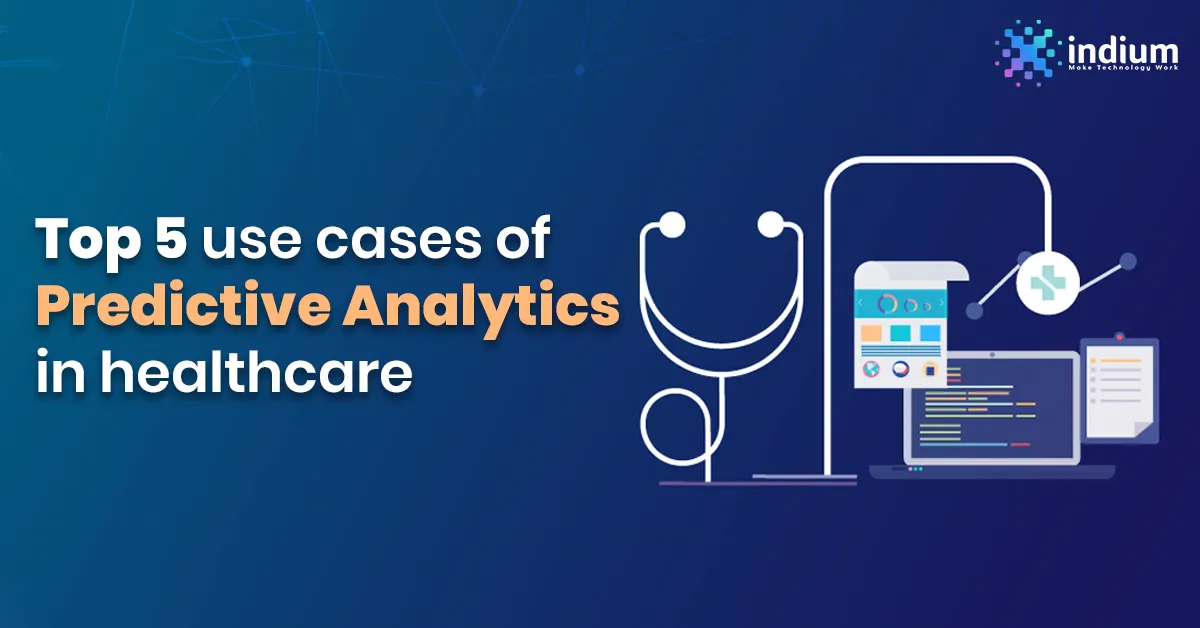Top 5 use cases of Predictive Analytics in Healthcare
Blog: Indium Software - Big Data
According to an Allied Market Research report, the global market for predictive analytics in healthcare is forecast to grow at a CAGR of 21.2 percent between 2018 and 2025, reaching $8,464 million. Increased adoption of electronic health records to efficiently manage patient outcomes and reduced overall costs are among the factors driving the demand for predictive analytics in healthcare, where it is paramount to be one step ahead of any eventuality.
How are healthcare organizations leveraging predictive analytics to derive actionable insights from their ever-growing datasets? We find out here.
Staying ahead of Patient Health Deterioration
It is the most essential application of predictive analytics in healthcare.
It helps caregivers react quickly to any change in a patient’s vitals and gather foresight into possible deterioration before symptoms are evident.
A 2017 study demonstrates this: at the University of Pennsylvania, a predictive analytics tool using machine learning and EHR data helped identify patients vulnerable to severe sepsis or septic shock a full 12 hours before the onset of the illness.
Read more about our Predictive Analytics Services and how we can help you
Read More
Predictive insights are particularly valuable in the intensive care unit (ICU), where timely intervention can help save someone’s life and prevent patient health deterioration.
The increased adoption of wearable biosensors offers manifold benefits, too, for care providers. They enable remote health monitoring and help detect early symptoms of health deterioration.
Preventing Patient self-harm
Early identification of individuals likely to self-harm will help provide the essential mental healthcare to avoid potentially serious or fatal events.
According to the World Health Organization, almost 800,000 people die of suicide each year, which is one person every 40 seconds.
Studies have showed that predictive analytics, using electronic health record (EHR) data and depression questionnaire, helps identify individuals at higher risk of committing suicides or other forms of self-harm.
In a study led by Kaiser Permanente (a leading American healthcare provider) and conducted together with Mental Health Research Network, EHR data combined with a depression questionnaire helped accurately detect those with a higher risk of attempting suicide.
Another study, featured on the American Journal of Psychiatry, aimed to build and validate predictive models with the help of electronic health records to predict suicide attempts and suicide deaths after an outpatient visit.
Based on predictors such as prior suicide attempts, mental health substance diagnoses, mental health and more, it was found that within 90 days of a mental health visit, suicide attempts and suicide deaths among individuals in the upper one percent of predicted risk were 200 times more common than those in the bottom half of the predicted risk scale.
Predicting patterns in patient utilization
Predictive analytics helps healthcare organizations ensure adequate staffing levels for busier clinic hours, minimize wait times and improve patient satisfaction.
With the help of big data visualization tools and analytics strategies to model patient flow patterns, healthcare centers can ensure the inpatient department has adequate beds available for patient admission, that the outpatient and physician offices have enough resources to reduce patient wait times and manage workflow and scheduling adjustments accordingly.
Scheduling changes help nurses and doctors cope with the increased patient flow while reducing the burden on them, thus ensuring they provide timely care and improve patient satisfaction.
Data Security
Predictive analytics and artificial intelligence (AI) play a key role in boosting cybersecurity, with the sophistication of cyberattacks (involving malware, phishing and more) rapidly on the rise.
Confidential patient information worth big money, a vast network of connected medical devices, outdated technology, among other factors, make the healthcare industry a constant target of cyberattacks.
Predictive analytics tools and machine learning help calculate real-time risk scores for different transactions and requests, making the system respond differently based on how the event is scored.
David McNeely from the Institute for Critical Infrastructure Technology says: “Once the risk score has been determined in real-time, the system can use this during a login event to either grant the access for a low-risk event or to challenge for Multi Factor Authentication [MFA] or possibly block the access for high-risk events.”
Create risk scores for chronic diseases
Early identification of individuals with a higher risk of developing chronic illnesses is essential for two reasons. It gives care providers and patients the best chance of preventing long-term health issues. It also helps mitigate the potential cost and complexities of the treatment.
By creating a risk score—from examining patients with identical characteristics, gathering lifestyle and clinical data and using algorithms to understand how various factors effect patient outcomes—healthcare providers gain insight into the type of therapy and wellness activities which can benefit their patients.
Leverge your Biggest Asset Data
Inquire Now
Leverge your Biggest Asset Data
Summary
As far as health management is concerned, prediction is the foundation for prevention and treatment. Predictive analytics helps healthcare providers in different ways. In addition to those mentioned above, the technology helps identify individuals likely to miss a clinical appointment and send timely reminders, manage supply chain to enhance efficiency and cut down on unnecessary costs, develop effective therapies and new medication, improve patient engagement and more.
Given its manifold benefits, it’s no wonder that, according to a 2017 study by the society of actuaries, 89 percent of healthcare providers were then either already using predictive analytics in their organizations or planned to in the next five years.
The post Top 5 use cases of Predictive Analytics in Healthcare appeared first on Indium Software.
